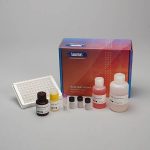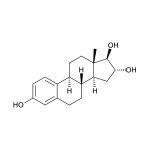Diagnostic Salivary Estriol ELISA Kit (CE Mark)
| Specifications |
|
Catalog#: |
1-2812 |
|
Regulatory Status: |
CE Mark |
|
Format: |
96-well plate |
|
Assay Time: |
~ 24 hrs |
|
Sample Volume/Test: |
100 µL of X2 dilution |
|
Sensitivity: |
1 pg/mL |
|
Assay Range: |
5 pg/mL - 1215 pg/mL |
|
Storage Requirements: |
2-8°C |
| Tests Per Kit |
|
Singlet: |
76 |
|
Duplicate: |
38 |
References & Salivary Estriol Research
-
-
- Troisi, R., Potischman, N., Roberts, J.M., et al. (2003). Maternal serum oestrogen and androgen concentrations in preeclamptic and uncomplicated pregnancies. Int J Epidemiol, 32(3), 455-60.
- Reis, F.M., D’Antona, D., Petraglia, F. (2002). Predictive value of hormone measurements in maternal and fetal complications of pregnancy. Endocr Rev, 23(2), 230-57.
- Vining, R.F., McGinley, R., Rice, B.V. (1983). Saliva estriol measurements: An alternative to the assay of serum unconjugated estriol in assessing feto-placental function. J Clin Endocrinol Metab, 56(3), 454-60.
- Kirkish, L.S., Compton, A.A., McCann, D.S. (1986). Salivary estriol as an index to fetal wellbeing. Clin Chem, 32(1 Pt 1), 71-75.
- Heine, R.P., McGregor, J.A., Goodwin, T.M., et al. (2000). Serial salivary estriol to detect an increased risk of preterm birth. Obstet Gynecol, 96(4), 490-97.
- Weintrob, N., Drouin, J., Vallette-Kasic, S., et al. (2005). Low estriol levels in the maternal triple-marker screen as a predictor of isolated adrenocorticotropic hormone deficiency caused by a new mutation in the TPIT gene. Pediatrics, 117(2), e322-7.
- Canick, J.A., MacRae, A.R. (2005). Second trimester serum markers. Semin Perinatol, 29(4), 203-8.
- Watson, C.S., Jeng, Y.-J., Kochukov, M.Y. (2008). Nongenomic actions of estradiol compared with estrone and estriol in pituitary tumor cell signaling and proliferation. FASEB J, 22(9), 3328-36.
- Jacobson, H.I., Lemanski, N., Agarwal, A., et al. (2010). A proposed unified mechanism for the reduction of human breast cancer risk by the hormones of pregnancy. Cancer Prev Res (Phil Pa), 3(2), 212-20.
- Larfors, G., Lambert, P.C., Lambe, M., et al. (2009). Placental weight and breast cancer survival in young women. Cancer Epid Biomark Prev, 18(3), 777-83.
-
- Hickey, M., Saunders, C., Partridge, A., et al. (2008). Practical clinical guidelines for assessing and managing menopausal symptoms after breast cancer. Ann Oncol, 19(10), 1669-80.
- Mascarenhas, C., Lambe, M., Bellocco, R., et al. (2006). Use of hormone replacement therapy before and after ovarian cancer diagnosis and ovarian cancer survival. Int J Cancer, 119(12), 2907-15.
- MacMahon, B. (2006). Epidemiology and the causes of breast cancer. Int J Cancer, 118(10), 2373-78.
- Lagiou, P., Samoli, E., Lagiou, A., et al. (2005). Maternal height, pregnancy estriol and birth weight in reference to breast cancer risk in Boston and Shanghai. Int J Cancer, 117(3), 494-98.
- Kassi, E., Moutsatsou, P. (2010). Estrogen receptor signaling and its relationship to cytokines in systemic lupus erythematosus. J Biomed Biotech, 2010:317452.
- Ding, J., Zhu, B.T. (2007). Unique effect of the pregnancy hormone estriol on antigen-induced production of specific antibodies in female BALB/c mice. Steroids, 73(3), 289-98.
- Rovenský, J. (2006). Rheumatic diseases and Klinefelter’s syndrome: Review. Scripta Med (Brno), 79(4), 237-46.
- Sicotte, N.L., Liva, S.M., Klutch, R., et al. (2002). Treatment of multiple sclerosis with the pregnancy hormone estriol. Ann Neurol, 52(4), 421-28.
- Soldan, S.S., Alvarez-Retuerto, A.I., Sicotte, N.L., Voskuhl, R.R. (2003). Immune modulation in multiple sclerosis patients treated with the pregnancy hormone estriol. J Immunol, 171(11), 6267-74.
- Kika, G., Izumi, S.-I., Mori, A., et al. (2009). Beneficial aspect of oral estriol as hormone replacement therapy: Consideration on bone and lipid metabolism. Tokai J Exp Clin Med, 34(3), 92-98.
- Drača, S. (2006). Estriol and progesterone: A new role for sex hormones. Int J Biomed Sci, 2(4), 305-7.
- Moutsatsou, V., Oakey, R.E. (1988). Oestriol binding to plasma proteins. J Steroid Biochem, 29(3), 319-23.
- Vining, R.F., McGinley, R.A., Symons, R.G. (1983). Hormones in saliva: Mode of entry and consequent implications for clinical interpretation. Clin Chem, 29(10), 1752-56.
- Evans, J.J., Wilkinson, A.R., Aickin, D.R. (1984). Salivary estriol concentrations during normal pregnancies, and a comparison with plasma estriol. Clin Chem, 30(1), 120-21.

 Contact: Salimetrics (USA)
Contact: Salimetrics (USA)
